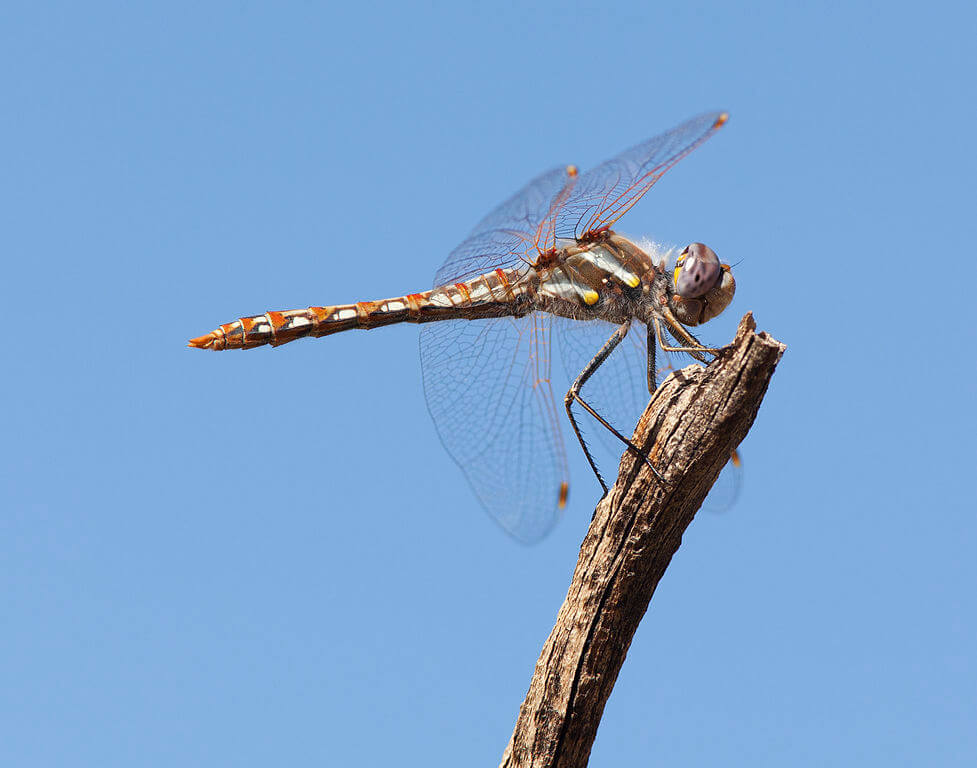Citizen Scientists Can Help Unravel the Mysteries of Dragonfly Migration
by Andrea Stephens
Broadcast 8.12 & 8.13.2012 and 7.7.2015

Variegated meadowhawk (Sympetrum corruptum), photo by Steve Berardi, CC 2.0.
Listen:
In August 2010, my family and I watched from our backyard an unbelievable phenomenon: a single species of dragonfly, individually numbering in the thousands, flew steadily westward across our property on the edge of town for 10 magical days, occasionally perching briefly—each one facing west—on the neighbor’s fence before continuing on. My mind went wild with questions. Were they migrating? What species were they? Where had they come from and where were they all going? I hiked up the hills due west of us along their line of travel, to see if they were indeed continuing on, instead of, perhaps, stopping at the local creek. Turns out the same species was flying west, up and over the hills and out of sight.
A digital camera and the internet turned out to be a big help that first year: a wonderful woman in Arizona helped me identify the species (Sympetrum corruptum, commonly known as the variegated meadowhawk), and after writing to the author of a guide book on dragonflies I found out that this species is migratory along the Pacific coast, but reports of them migrating within or through Montana apparently are unknown.
According to the Xerces Society for Invertebrate Conservation, 16 North American dragonfly species make migrations, including the variegated meadowhawk. Apparently, large body size is a prerequisite for insect migration, since only those species with large flight muscles can attain the speeds needed to overcome ambient winds. So it’s no surprise that within the insect world, only some dragonflies, butterflies and moths are known to migrate. While certain moths migrate by passively using air currents, migratory dragonflies, in the same way as the well-known monarch butterflies, undertake directional movement regardless of prevailing wind direction. This is certainly what we witnessed during our meadowhawk event two years ago. Every individual we observed over more than two weeks was headed west, despite headwinds that seemed to ground some of them in the tall grass for short periods of time.
A Xerces report comments that scientists currently studying migratory behavior in dragonflies are in about the same position as researchers studying monarch butterflies forty years ago. We know a phenomenon exists, but most of the details remain to be worked out. Which is one thing that made our meadowhawk spectacle so exciting: citizen scientists have much to contribute to our collective understanding of dragonfly migration, if that is indeed what we were witnessing.
Xerces co-chairs a unique collaborative, the Migratory Dragonfly Partnership (MDP). According to the MDP website, one of their missions is to develop an international network of citizen scientists to monitor the spring and fall movements of the main migratory species in North America. The primary volunteer project of MDP is the Dragonfly Pond Watch. If you live near a wetland, or visit one regularly, you can offer up your observations of the annual movement of two specific migratory dragonflies, one of which is found in Montana, the common green darner. Our scientific understanding of dragonfly migration can be advanced by widespread observational data, which thoughtful, interested citizens across the country are perfectly poised to gather.
In August 2011, at Smith Pass in the Swan Mountain Range, I watched what may have been another migratory event: hundreds of dragonflies moving west over the snow-covered divide at about 7,000 feet! While I wasn’t able to catch any of these for proper identification, since they flew so far overhead, the event further spurred my interest and made me hope that we can develop a network of interested citizen scientists who can make and compare their observations of these fascinating insects.
Every week since 1991, Field Notes has inquired about Montana’s natural history. Field Notes are written by naturalists, students, and listeners about the puzzle-tree bark, eagle talons, woolly aphids, and giant puffballs of Western, Central and Southwestern Montana and aired weekly on Montana Public Radio.
Click here to read and listen to more Field Notes. Field Notes is available as a podcast! Subscribe on iTunes, Google Play, or wherever you listen to podcasts.
Interested in writing a Field Note? Contact Allison De Jong, Field Notes editor, at adejong [at] montananaturalist [dot] org or 406.327.0405.
Want to learn more about our programs as well as fun natural history facts and seasonal phenology? Sign up for our e-newsletter! You can also become a member and get discounts on our programs as well as free reciprocal admission to 300+ science centers in North America!












